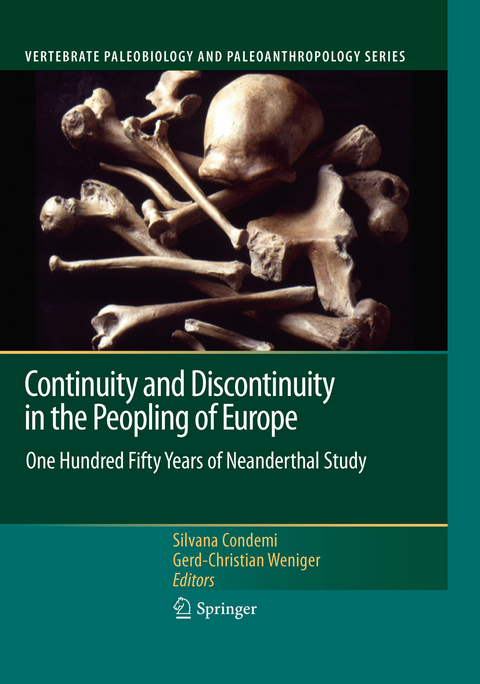
Continuity and Discontinuity in the Peopling of Europe
Springer (Verlag)
978-94-007-3554-5 (ISBN)
Silvana Condemi is an anthropologist who studied at the Universities of Paris VI and Bordeaux (France). She is currently Director of Research at the Centre National de la Recherche Scientifique (CNRS) in the laboratory of Anthropology at the University of Marseille, where she directs the unit of paleoanthropology. She has specialized in Pleistocene human evolution, in particular concerning the origin and evolution of Neanderthals and on the emergence of modern humans. She conducts field work in the Middle East and Europe. Her research focuses on interpretation of the archeological record, on patterns of human anatomical variation, the relationship between genetics and environment, ecogeographical patterning and, more recently, collaboration on ancient DNA analysis and modelling of Neanderthal populations. Gerd-Christian Weniger is a palaeolithic archaeologist with special interest in human cultural and biological evolution during the Upper Pleistocene in Europe and the Near East. Since 1991 he is professor of Prehistory at the University of Cologne and since 1996 he is director of the Neanderthal Museum. His current research includes the Middle to Upper Palaeolithic transition in Europe. As director of the Neanderthal Museum he is engaged in various research projects including field work in the Western Mediterranean and directing NESPOS an interactive online database on the archaeology and anthropology of Neanderthals.
1. The Genus Homo: Origin, Speciation and Dispersal. - 2. Before the Neanderthals: Hominid Evolution in Middle Pleistocene Europe. - 3. The Earliest European Human Peopling after the Recent Discoveries: Early Neanderthals or Different Lineages?. - 4. The Gran Dolina-TD6 Human Fossil Remains and the Origin of Neanderthals. - 5. The Hominid Fossils from China Contemporaneous with the Neanderthals and Some Related Studies. - 6. Behavioral and Cultural Origins of Neanderthals: A Levantine Perspective. - 7. Discontinuities in the Faunal Assemblages and Early Human Populations of Central and Western Europe during the Middle and Late Pleistocene. - 8. Neanderthal Geographical and Chronological Variation. - 9. A Preliminary Approach to the Neanderthal Speciation by Distance Hypothesis: a View from the Shoulder Complex. - 10. Facts and Ideas in Paleolithic Growth Studies (Paleoauxology). Evidence from Neanderthals in Europe. - 11. Dental Development and Age at Death of a Middle Paleolithic Juvenile Hominin from Obi-Rakhmat Grotto, Uzbekistan
12. Computerized Reconstruction of Prenatal Growth Trajectories in the Dentition: Implications for the Taxonomic Status of Neandertals. - 13. Endostructural Characterisation of the Regourdou 1 Neanderthal Proximal Arm: Bilateral Asymmetry and Handedness. - 14. A Three-dimensional Lookat the Neanderthal Mandible. - 15. Integration and Homology of "Chignon" and "Hemibun" Morphology. - 16. Virtual Synthesis of the Skull in Neanderthals by FESS. - 17. Neandertal mtDNA from a Late Pleistocene Human Mandible from the Cova del Gegant (Spain). - 18. Towards Neanderthal Paleogenomics. - 19. Twelve Years of Neandertal Genetic Discoveries : State-of-the-art and Future Challenges. - 20. Radiocarbon Dating the Middle to Upper Palaeolithic Transition: the Demise of the Last Neanderthals and the First Appearance of Anatomically Modern Humans in Europe. - 21. Archaeological, Paleontological and Genomic Perspectives on Late European Neandertals at Vindija Cave, Croatia. - 22. Late Neandertals and Early Modern Humans in Europe: Population Dynamics and Paleobiology. - 23. Aliens from Outer Time? Why the "Human Revolution" Is Wrong, and Where Do We Go from Here? . - 24. Neandertals and the Roots of Human Recency. - 25. Epilogue 150 Years of Neanderthal
| Reihe/Serie | Vertebrate Paleobiology and Paleoanthropology |
|---|---|
| Zusatzinfo | XXII, 386 p. |
| Verlagsort | Dordrecht |
| Sprache | englisch |
| Maße | 210 x 279 mm |
| Themenwelt | Geisteswissenschaften ► Archäologie |
| Naturwissenschaften ► Biologie ► Evolution | |
| Naturwissenschaften ► Biologie ► Humanbiologie | |
| Naturwissenschaften ► Geowissenschaften ► Mineralogie / Paläontologie | |
| Sozialwissenschaften ► Ethnologie | |
| Sozialwissenschaften ► Soziologie | |
| ISBN-10 | 94-007-3554-5 / 9400735545 |
| ISBN-13 | 978-94-007-3554-5 / 9789400735545 |
| Zustand | Neuware |
| Haben Sie eine Frage zum Produkt? |
aus dem Bereich


